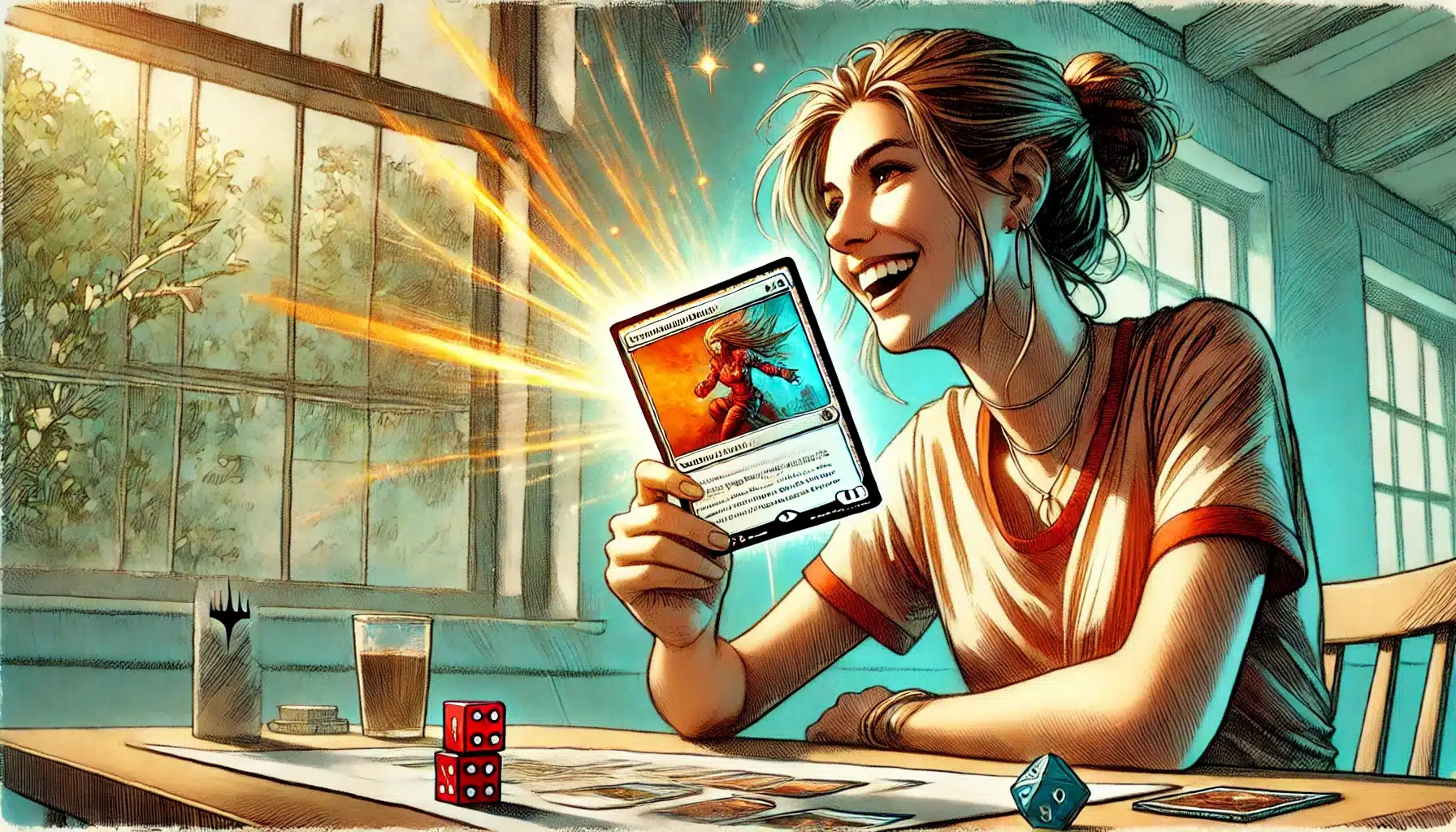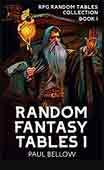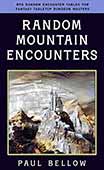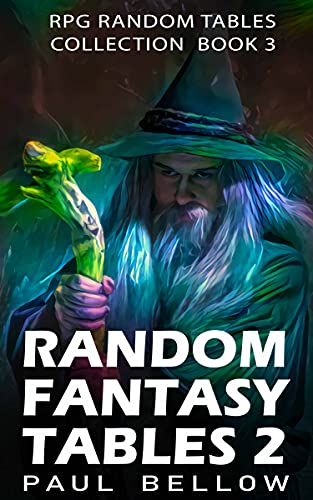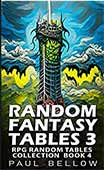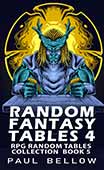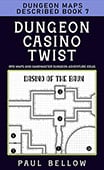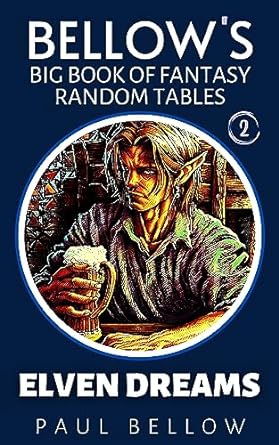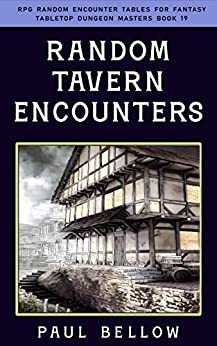In the world of Magic: The Gathering, the vibrant multiverse has always thrived on its unique blend of fantasy storytelling, intricate mechanics, and a loyal, passionate community. However, recent years have brought a significant shift in Magic’s landscape with the introduction of Universes Beyond. This initiative, which incorporates beloved external franchises into the game, has sparked excitement and controversy. As Magic embraces these ambitious crossovers, questions arise about the balance between maintaining the integrity of its core lore and embracing a broader universe of storytelling possibilities.
With Universes Beyond, Wizards of the Coast aims to expand Magic’s reach by tapping into the massive popularity of other well-established franchises. The allure of seeing iconic characters and settings from worlds like Warhammer 40,000, Final Fantasy, and Marvel’s Spider-Man within the framework of Magic has intrigued many. Still, it also stirs debate about whether these crossovers enhance or dilute the game’s appeal.
This article delves into the rise of Universes Beyond, its potential impact on Magic’s lore, and the community’s mixed reactions. By examining both the opportunities and challenges that come with these crossovers, we aim to uncover whether Universes Beyond can coexist harmoniously with Magic’s own multiverse, or if there’s a risk of overwhelming the game’s distinct identity.
The Rise of MtG Universes Beyond
Magic: The Gathering, over its decades-long history, has grown into a behemoth within the gaming world, celebrated for its deep lore and intricate mechanics. However, recognizing the opportunity to reach even broader audiences, Wizards of the Coast introduced Universes Beyond—a series of expansions that integrate popular external franchises into the Magic universe. This bold move followed a modern entertainment trend: blending different worlds to create a richer, more engaging experience for fans.
Universes Beyond started as a way to pull traditional and new Magic players into a shared experience by drawing on beloved franchises. The inclusion of Warhammer 40,000 marked one of the first of these ambitious crossovers, followed by others such as Doctor Who, Street Fighter, and even The Lord of the Rings. The goal was to draw not only from the lore and iconography of these franchises but also their vast, loyal fanbases, turning passionate fans of other series into Magic enthusiasts.
The crossovers introduced a fresh creative space for Magic, offering new gameplay mechanics inspired by the crossover franchises while maintaining the strategic depth Magic players love. These expansions also served the purpose of injecting a new visual and thematic variety into the game, promising fresh landscapes, characters, and stories that would complement, rather than replace, traditional Magic settings.
Try my AI Tabletop RPG generators...and an extensive library of content!
By exploring these crossovers, Wizards aimed to break traditional boundaries and build connections with audiences who might not have previously considered Magic. New players who enter the game through these franchises often find themselves enticed by Magic’s core mechanics and lore, broadening the player base while maintaining engagement with veteran players through innovative content.
- Warhammer 40K – Commander Decks (2022, physical)
- The Lord of the Rings – Full Set (2023, physical/digital)
- Doctor Who – Commander Decks (2023, physical)
- Final Fantasy – Full Set (2025, physical/digital)
- Marvel’s Spider-Man – Full Set (2025, physical/digital)
- Street Fighter – Secret Lair (2022, physical/digital)
- Stranger Things – Secret Lair (2021, physical/digital)
- Fallout – Commander Decks (2024, physical)
- Walking Dead – Secret Lair (2020, physical)
- Assassin’s Creed – Booster Set (2024, physical/digital)
The sheer diversity of crossover products illustrates Universes Beyond’s expansive reach. By offering unique formats and leveraging both digital and physical platforms, Wizards of the Coast hopes to keep Magic dynamic and relevant in a rapidly changing gaming landscape.
As Universes Beyond continues to expand, it remains a topic of both admiration and scrutiny. The success of these products will depend largely on how well they integrate with Magic’s core themes and how effectively they attract new players while satisfying long-term fans. Ultimately, the balance Wizards of the Coast strikes between maintaining Magic’s identity and exploring new storytelling avenues will determine the initiative’s lasting impact on the game.
2025 Set Schedule: Original vs. Crossover Content
Magic’s 2025 product calendar presents a fascinating landscape of both original content and Universes Beyond crossovers, marking a strategic attempt by Wizards of the Coast to maintain a delicate balance between honoring Magic’s origins and embracing new, exciting narratives. This year will see an almost equal split between traditional Magic sets and crossover entries, reflecting a deliberate approach to capture the interest of diverse audiences.
⚔️ Fantasy RPG Random Tables Books
Make life as a Gamemaster easier…
If you play Dungeons & Dragons, Pathfinder, or other fantasy RPGs, this
RPG random tables series
is packed with encounters, NPCs, treasure, and more. Available in eBook or print—either way, you’ll have a wealth of adventure ideas at your fingertips.
The year kicks off with “Innistrad Remastered,” an original setting steeped in gothic horror and rich lore that Magic players have come to love. Following closely, “Aetherdrift,” set for February, promises original magic and mechanics that evoke the spellbinding charm intrinsic to Magic’s universe. “Tarkir: Dragonstorm” in April will revisit one of Magic’s most thrilling planes, renowned for its dragon-infused battles and ancient sagas.
However, June marks the crossing of universes with “Final Fantasy,” a much anticipated full set crossover. This set is expected to marry the intricate lore of Final Fantasy with Magic’s mechanics, creating a synergy between strategic depth and iconic characters. Later, in September, “Marvel’s Spider-Man” enters the arena, blending superhero excitement with Magic’s tactical gameplay. Finally, “Avatar: The Last Airbender” closes the year in November, promising elemental battles and strategic innovation.
This strategic mix of original and crossover content is not accidental. Wizards of the Coast is keenly aware of the need to nurture Magic’s established worlds while exploring the popularity of beloved global franchises. By maintaining a roughly equal split, they aim to satisfy existing fans who cherish Magic’s traditional lore while attracting new players through recognizable crossover names.
- Innistrad Remastered (Original) – January
- Aetherdrift (Original) – February
- Tarkir: Dragonstorm (Original) – April
- Final Fantasy (Crossover) – June
- Edge of Eternities (Original) – August
- Marvel’s Spider-Man (Crossover) – September
- Avatar: The Last Airbender (Crossover) – November
To sum up, 2025 will be a defining year for Magic, showcasing Wizards’ commitment to both innovation and tradition. This carefully curated calendar reflects a strategic vision aimed at weaving a cohesive narrative experience across both original Magic lore and external franchises. Through this blend, Wizards hopes to highlight the strengths of Magic’s multiverse while celebrating the diversity brought by Universes Beyond.
As fans eagerly await the unfolding of these sets, the delicate balance between original and crossover content remains under the spotlight. This strategy offers exciting potential for the future, fostering a harmonious interplay between the ingenious worlds of Magic and the celebrated universes brought into its fold.
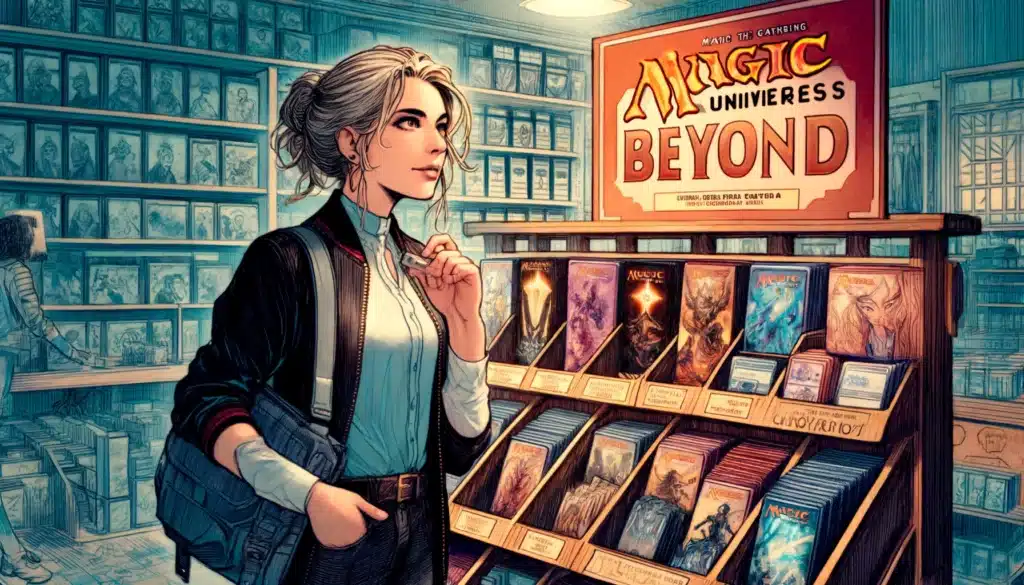
Legal Integration into Standard Formats
A pivotal change is on the horizon for Magic’s integration strategy: beginning in 2025, all Universes Beyond booster sets will become Standard-legal, marking a significant policy shift from previous approaches. Until now, crossover sets were predominantly limited to Commander decks or promotional products, leaving Standard—a competitive format in the Magic community—largely untouched by external narratives. This shift represents an ambitious step in blending Magic’s core gameplay with diverse storytelling from other franchises.
The decision to allow crossover sets into Standard is not without its implications. By opening the gates to these properties, Wizards of the Coast aims to revitalize Standard with fresh mechanics and narratives that could enhance deck diversity and excite players. Yet, the introduction of such varied new elements poses potential challenges for card balance, gameplay integration, and the sense of narrative cohesion within Standard.
Magic’s community boasts passionate players with diverse perspectives, and this shift has elicited mixed reactions. Some fans welcome the potential for innovation, viewing crossovers as a chance to refresh Standard’s strategic landscape. Others, however, express concern over how these crossovers might disrupt the format’s balance, blending lore and mechanics that were never originally designed to coexist.
- Impact on Standard deck diversity: Could broaden options but risk imbalance.
- Effects on competitive formats: Introduction of non-traditional mechanics may upend typical strategies.
- Card balancing challenges: Ensuring fair play amidst diverse mechanics could prove difficult.
- Lore blending in gameplay: Opportunity for unique interactions, but risks coherence issues.
- Potential for confusion with new players: New layers may overwhelm those unfamiliar with Magic.
- Brand integrity concerns: Melding outside IP might dilute Magic’s core identity.
- Cross-franchise mechanics integration: Opportunities for creativity, yet poses design challenges.
- Precedent-setting decision: Opens doors for more frequent future crossover inclusions.
The decision to integrate Universes Beyond into Standard underscores Wizards’ confidence in the potential of crossovers to enrich gameplay while expanding the game’s appeal. By including diverse franchises under the Standard umbrella, Magic stands to offer a more varied and engaging player experience.
In conclusion, Standard’s evolution marks a bold move for Magic, full of both potential and challenges. The key to its success will lie in Wizards’ ability to maintain a delicate balance between innovation and preservation, ensuring that the introduction of Universes Beyond into Standard serves to enhance, rather than overshadow, Magic’s established lore and gameplay.
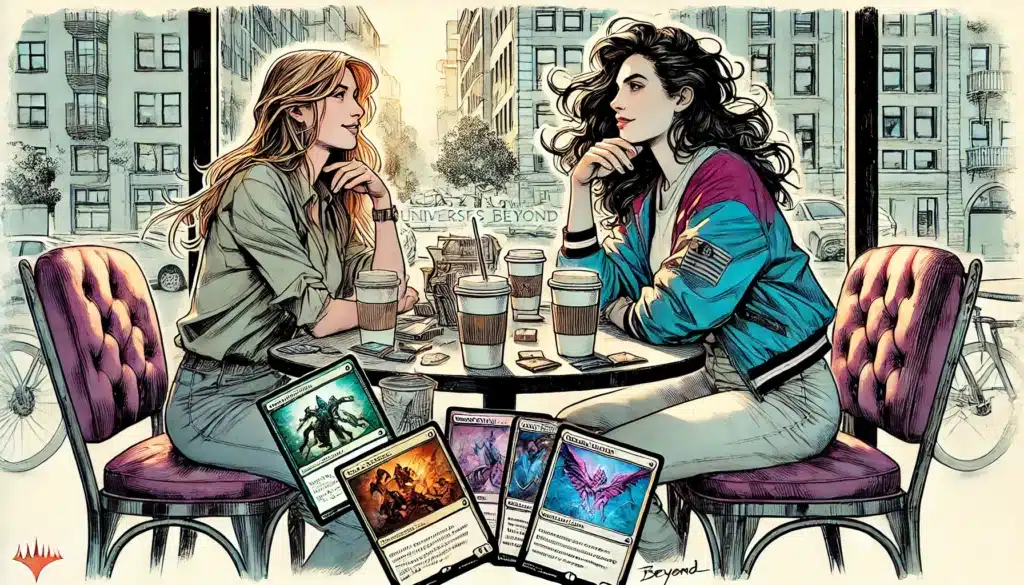
Fan Reactions and Lore Implications
As Magic: The Gathering continues its journey through Universes Beyond, a spirited debate has emerged within the community. At the heart of the discussion is whether these crossovers enhance or dilute Magic’s core multiverse and the long-term appeal of the game. Passionate players find themselves at a crossroads, contemplating the potential of Universes Beyond to introduce fresh perspectives or encroach upon the lore that has enamored them for decades.
⚔️ Fantasy RPG Random Tables Books
Make life as a Gamemaster easier…
If you play Dungeons & Dragons, Pathfinder, or other fantasy RPGs, this
RPG random tables series
is packed with encounters, NPCs, treasure, and more. Available in eBook or print—either way, you’ll have a wealth of adventure ideas at your fingertips.
On one side of the debate, proponents embrace the crossovers as a means of revitalizing Magic with exciting new narratives and mechanics. These fans see crossover sets as an opportunity to experience favorite franchises in a new light, creating imaginative gameplay interactions that enrich the Magic experience. They argue that Universes Beyond serves as a bridge, inviting fans of other universes to step into Magic, thus broadening the player base.
Conversely, critics express concern over what they perceive as a drift from Magic’s roots. For these players, the frequent release of crossover sets risks overshadowing Magic’s original planes and narratives such as Dominaria, Zendikar, and Ravnica. They worry that the allure of external franchise narratives might dilute the cohesive lore built over decades, replacing Magic’s distinctive identity with a patchwork of non-native stories.
Support for the Crossover Initiative
For many in the Magic community, Universes Beyond represents an exciting frontier, and the positive sentiments surrounding this initiative are notable. Fans who support these crossovers highlight the fresh energy and broader accessibility they bring to Magic’s gameplay and culture. The cross-pollination of beloved franchises creates a dynamic tapestry of stories, inviting longtime fans and newcomers alike to experience Magic in novel ways.
One of the most compelling reasons fans embrace crossovers is the increased accessibility they offer. By bringing Magic into the realms of universally recognized franchises, Wizards of the Coast effectively lowers barriers, making the game more approachable to diverse audiences. The allure of seeing beloved characters and settings within Magic’s strategic framework is a powerful draw for franchise enthusiasts, encouraging them to explore Magic’s rich gameplay.
Moreover, Universes Beyond introduces exciting collectible appeal. These sets offer unique art styles and thematic elements that spark delight among collectors and players invested in the lore of both Magic and the involved franchises. The creative experimentation allowed by these crossovers lets designers push boundaries, resulting in innovative mechanics and fresh story interactions that enrich the gameplay experience.
- Increased accessibility for new players
- Exciting collectible appeal with unique art
- Mechanically innovative gameplay developments
- Franchise nostalgia enhances engagement
- Expands marketing reach to diverse audiences
- Potential for unique story interactions across universes
- Visual variety that enriches the Magic aesthetics
- Appeals to casual players seeking familiar themes
- Celebration of broader pop culture within Magic
These factors contribute to a sense of freshness and excitement that supporters believe reinvigorates the Magic universe. By blending classic Magic elements with beloved cultural touchstones, Universes Beyond presents opportunities for storylines and gameplay interactions that transcend what Magic could achieve on its own.
In essence, the enthusiasm for Universes Beyond underscores a belief in the potential of crossovers to enrich Magic’s landscape, not merely as a novelty but as an evolution of what the game can be. As the initiative unfolds, its ability to convert fresh excitement into long-term engagement will determine its success in capturing both the hearts and minds of Magic’s diverse audience.
Concerns About Lore Overload
While crossovers bring undeniable excitement, there is a growing concern that Magic’s frequent embrace of Universes Beyond risks pushing its core settings into the shadows. As Wizards of the Coast introduces more crossover sets, some in the community fear that the foundational planes of Magic—Dominaria, Zendikar, Ravnica—may be overshadowed by a parade of non-native narratives and settings.
Try my AI Tabletop RPG generators...and an extensive library of content!
Critics argue that the steady drumbeat of crossover releases could dilute the unique allure of Magic’s own lore. The introduction of external characters and settings, while exciting, sometimes jars against the established tone and continuity of Magic’s multiverse, creating potential mismatches in flavor and narrative coherence. Established planeswalkers and storylines that have long been the backbone of Magic’s storytelling risk being sidelined in favor of new, externally-driven narratives.
Such concerns extend to fears of identity confusion, where the blending of diverse franchises might muddy the distinctive characteristics that define Magic’s world. The risk of narrative inconsistency looms as new sets introduce storylines and mechanics that don’t easily integrate with pre-existing lore. This could lead to a detachment for players who are deeply invested in Magic’s original worldbuilding.
- Lore dilution creating less cohesive narratives
- Identity confusion amidst diverse storytelling elements
- Disconnection from Magic’s established planeswalkers
- Narrative inconsistency hindering lore development
- Flavor mismatches due to contrasting thematic elements
- Lack of continuity between Magic’s past and present
- Alienation of long-term fans invested in original lore
- Crossover fatigue from constant influx of new settings
- Perception of crossovers as mere marketing gimmicks
- Overshadowing of Magic’s original worldbuilding efforts
- Saturation of licensed content diminishing Magic’s identity
These critiques reflect genuine concerns from fans who fear that Magic could become a vessel for licensed content rather than a leader in original storytelling. As more crossovers are introduced, Wizards of the Coast must consider how best to balance tradition with innovation, ensuring that Universes Beyond complements rather than overwhelms Magic’s distinctive narrative identity.
Ultimately, the challenge lies in finding a harmonious balance that celebrates the richness of Magic’s own worlds while embracing the opportunities offered by Universes Beyond. As the community voices its concerns, Wizards’ response will be crucial in shaping the future trajectory of Magic’s lore and ensuring the game’s continued resonance with its dedicated fan base.
Wizards’ Response and Balancing Strategy
In light of the varied reactions to Universes Beyond, Wizards of the Coast is actively addressing community concerns while striving to maintain the integrity of Magic’s core identity. Their approach centers on balancing original Magic content with crossover sets, an endeavor reflected in their strategic decisions for upcoming releases. By doing so, they aim to reconcile innovation with tradition, ensuring that Magic’s unique lore remains vibrant and compelling.
Wizards has expressed a commitment to alternating set themes, ensuring a consistent flow of original Magic content interspersed with crossover releases. By preserving established storylines within Magic’s iconic planes, they aim to cultivate a dynamic narrative environment that acknowledges Magic’s past while embracing new adventures.
The development of new Magic-original characters and storylines remains a priority in their strategy, ensuring that the heart of Magic’s culture is nurtured alongside Universes Beyond. Furthermore, Wizards is dedicated to maintaining visual design consistency across sets, blending the distinct aesthetics of crossover franchises with Magic’s signature style.
- Alternating set themes between original and crossover content
- Preserving continuity in Magic’s iconic planes
- Maintaining lore-based justification for global crossovers
- Ensuring visual design consistency across diverse sets
- Development of new Magic-original characters and storylines
- Continued investment in Magic novels for immersive storytelling
- Standard set release parity between original and crossover content
These efforts underscore Wizards’ intention to strengthen Magic’s narrative foundation, preserving the game’s rich lore while exploring new horizons. They are also investing in Magic novels and storytelling mediums to expand and deepen Magic’s lore, ensuring fans have access to a well-rounded narrative experience.
In summary, Wizards of the Coast is embracing the challenge of balancing innovation and tradition with a thoughtful strategy that honors Magic’s past while enthusiastically venturing into new territories. This delicate balancing act reflects a broader commitment to crafting stories that resonate with players old and new, affirming Magic’s place as both a storied universe and an innovative gaming phenomenon.
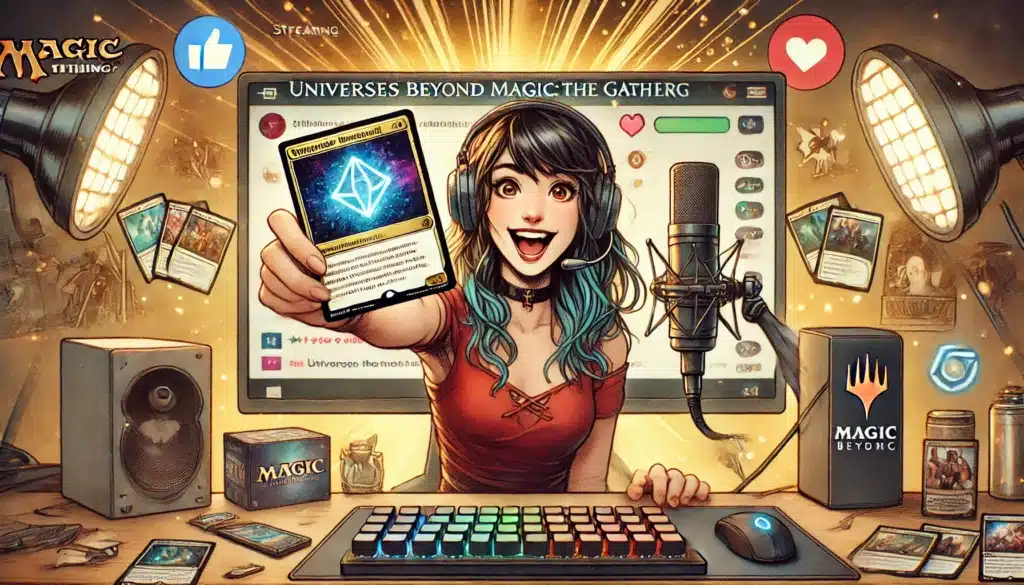
Final Thoughts on the Future of MtG Universes Beyond
As we peer into the evolving landscape of Magic: The Gathering, the ongoing tension between innovation and tradition looms large. Universes Beyond has undoubtedly introduced fresh perspectives and narratives, inviting new players into the fold while offering existing fans a broader range of storytelling experiences. However, the question remains—will these crossovers ultimately strengthen Magic’s foundation, or will they dilute the distinct lore that has captivated players for decades?
The potential for crossovers to reignite interest and infuse Magic with cultural relevance is certainly enticing. By leveraging beloved franchises, Wizards of the Coast taps into global fanbases that can invigorate the Magic community and introduce new creative possibilities. However, the risk of displacing Magic’s original content with external narratives poses a real threat to its long-term identity.
The future of Universes Beyond, and Magic as a whole, will hinge on finding harmony between maintaining the essence of Magic’s universe and embracing the allure of external franchises. If managed wisely, crossovers could become a powerful tool for storytelling and gameplay innovation without overshadowing Magic’s beloved planes and characters.
As we consider the path ahead, it’s clear that the role of Universes Beyond will depend on careful execution and thoughtful engagement with the community. The balance between original content and crossovers must remain a focal point, ensuring that Magic continues to evolve while holding true to its roots. By cultivating a shared narrative space where Magic’s traditional worlds meet new and exciting franchises, Wizards of the Coast has the opportunity to craft a future as compelling and expansive as the multiverse itself.
Reflecting on this potential underscores the importance of collaboration between creators and fans, fostering a community-driven environment that embraces both change and continuity. Ultimately, Universes Beyond can serve as both an opportunity and a challenge—a testament to Magic’s enduring allure and its capacity to adapt and grow in an ever-changing world of fantasy and imagination.

